diagonal - Having a slanted direction. Any straight edge or line that is neither horizontal nor vertical is diagonal. A diagonal cut or fold of woven fabric is said to be "on the bias."
Examples of works with bold diagonal elements:

Francisco Goya (Spanish, 1746-1828), The
Forge, between c. 1815 and 1820, oil
on canvas, 71 1/2 x 49 1/4
inches (181.6 x 125.1 cm), Frick Collection, NY. See Romanticism and expression.

George Wesley Bellows (American, 1882-1925),
Stag at Sharkey's, 1909, oil
on canvas, 36 1/4 x 48 1/4
inches (92 x 122.6 cm), Cleveland Museum of Art. See Ashcan
school.

A. M. Cassandre [pseudonym of Adolphe Jean-Marie
Mouron] (born in the Ukraine 1901, died 1968, worked in France
and the USA), L´Intransigeant, Le plus fort,
1925, lithograph in black,
blue, red and gold inks, Kunstbibliothek,
Berlin. See poster.
James N. Rosenberg (American, 1874-1970), Oct 29 Dies Irae ("Days of Wrath"), 1929, lithograph, printed by George Miller, Library of Congress, Washington, DC. Rosenberg was a bankruptcy lawyer in Manhattan who also studied lithography. Having witnessed the morning the stock market's most famous crash, Rosenberg spent the second half of that day producing this picture. Rosenberg's liberal use of diagonal's in the composition magnifies the intensity of the anxiety it expresses.
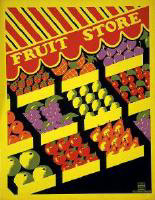
American, Federal
Art Project (FAP), New York, Fruit Store, c. 1941, poster, Library
of Congress, Prints & Photographs Division, WPA Poster Collection,
LC-USZC4-5064.
Ellsworth Kelly (American, 1923-), Black/white (EK 765), 1988, oil on canvas (two connected canvases), 224 x 231.5 cm, Centre Georges Pompidou, Paris. See Minimalism.
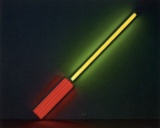
Dan Flavin (American, 1933-), the alternate diagonals of March 2, 1964 (to Don Judd), 1964, red and yellow fluorescent light, 145 x 12 x 4 inches (368.3 x 30.5 x 10.2 cm), Museum of Contemporary Art, Chicago.

Claes Oldenburg and Coosje van Bruggen (Dutch-American,
1942-), Stake Hitch, 1984, aluminum,
steel and urethane
foam, 642 x 182 x 534 inches (1630.7 x 462.3 x 1356.4 cm), Dallas
Museum of Art. See polyurethane.
![]()

![]()
Bruce Ackerson (American, contemporary), Summer Job, 1997, oil on panel, 24 x 24 inches, OK Harris Gallery, NY.
Also see align and alignment and marbling.
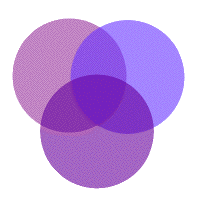 diagram - A sketch,
drawing, outline,or plan
designed to demonstrate
or explain how something works. Not necessarily representational,
it outlines, explains, or clarifies the arrangement
of and relationship between the parts of a whole. Or to make such
an image.
diagram - A sketch,
drawing, outline,or plan
designed to demonstrate
or explain how something works. Not necessarily representational,
it outlines, explains, or clarifies the arrangement
of and relationship between the parts of a whole. Or to make such
an image.
A Venn diagram such as this one can be labeled to show how three things possess aspects which overlap, and others which do not. See concentric and eccentric.
Related link:
Also see bubble diagram, didactic, graph, graphic design, map, mathematics and art, silhouette, and theory.
diameter - A straight line segment passing through the center of a figure, especially of a circle or sphere, and terminating at its edge.The length of such a line. Also, thickness or width. Half of the diameter — the distance from the center to the edge — is the radius.
diaper - An all-over repeat pattern or design, usually on fabric or walls, usually composed of clearly defined geometric elements, often of diamond-shaped figures. (Some of us even wear them.)
diaphragm arch - See arch.
dicromasy - See colorblind or color-blind,or colorblindness.
didactic - Something which is intended to instruct. Sometimes, to be morally instructive. "Didaktikos" is a Greek word that means "apt at teaching." It comes from "didaskein," meaning "to teach." Something didactic does just that: teaches or instructs. Didactic conveyed that neutral meaning when it was first borrowed in the 17th century, and still does; a didactic piece of work is one that is meant to be instructive as well as artistic. Genre painting and sculpture — narrative and often allegorical — is apt to be didactic, especially when its aim is to teach a moral lesson. Didactic now often has negative connotations, because something didactic can be over burdened with instruction to the point of being dull. Or it might be pompously instructive or moralistic.
(pr. di:-DAK-təc)
One synonym for teacher is didact.
Also see diagram, graph, heuristic, and map.
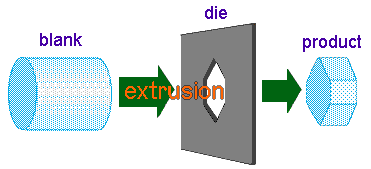
die - A device used for cutting out, forming, or
stamping (blank) material.
Most common types include: a metal block which has one or more small holes through which plastic, metal, or other ductile metal is extruded or drawn; a metal
piece with a surface having
a relief design
used for impressing that design onto a softer metal, as in striking
coins; each of the cutting elements of a die stock used to cut
threads on screws or bolts; a part on a tool that punches shaped holes in, cuts, or  forms
sheet metal, cardboard or
another material.
forms
sheet metal, cardboard or
another material.
The plural form is dies.
Hasbro's "Fun Factory" is a tool for extruding Play-Doh® through strips of plastic dies. Play-Doh is a modeling compound with similar physical properties to clay, but it is not actually ceramic.
Also see dapping block, dye, extrusion, intaglio, numismatics, punch, stamp, template, trussel, and wire.
different and difference - Not the same, various, diverse (diversity). One of modernism's most pervasive characteristics is its embrace of what's new. While postmodernism's expectations of newness are not as intense, difference remains an attribute we crave. Nevertheless, one of the most shallowly used terms used in art criticism, "different" is too often the only reaction of a viewer who has discerned nothing else about a work than its variation from some norm. Faint praise.
Quotes:

Also see change, choose, colorblind, compare, definition, eccentric, gender issues, interdisciplinary, letterform, multiculturalism, nuance, variation, variegated, variety, vary, xenophilia, and xenophobia.
differential focus - A photographic technique in which everything in the foreground shows clearly, while everything in the background is less distinct, or visa-versa.
diffraction grating - Sheets of glass, plastic, or metal inscribed with grids whose lines or dots diffract any light directed at the gridded surface and break this light up into its color spectra so that the rays may be measured accurately.
digital camera - A camera that directly captures a digital image without the use of film.
Other resources:
Also see JPEG.
digital fingerprint - See watermark.
digital image - An electronically processed image composed of bits and bytes, usually coming from use of a computer.
Related links:
Also see Adobe, aliased and anti-aliased, bit-mapped image, CAD, clipart, computer graphics, digitizing, graphic arts, graphic design, GraphicConverter, moiré, monitor, new media, photomechanical graphic, Photoshop, scanner, tradigital, vector graphic, wireframe, and World Wide Web (WWW).
digital photography - See computer graphics, digital camera, digital image, photography, and photomechanical graphic.
digitizing - To convert an image into binary code. Visual images are digitized by scanning them and assigning a binary code to the resulting vector graphic or bit-mapped image data.
Also see bit-mapped image, CAD, computer graphics, digital image, monitor, new media, photomechanical graphic, scanner, vector graphic, and wireframe.
dikka - Important in Islamic tradition, a dikka is a platform in a mosque, often made of wood, in line with the mihrab, that holds muezzins who chant in unison with the Imam (prayer leader) as he prays.
An example:
![]()
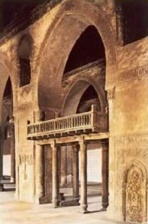
The Dikka in the Ibn Tulun Mosque, Cairo.
![]()
dilettante - Originally, an admirer or lover of the arts, a connoisseur. Or, a dabbler in an art or a field of knowledge; an amateur. Today, "dilettante" is more likely to be used in the latter sense, and taken by many — by the listener, even if not by the speaker — as an insult. It was more innocent in its original uses, as derived from the Italian word "dilettare," meaning "to delight." In the 18th century, a dilettante was simply a person who delighted in the arts. Later, the term came to refer to an amateur — someone who cultivates an art as a pastime without pursuing it professionally. From this meaning developed the pejorative meaning the word carries now: a person who dabbles in an art, but is not truly devoted to it. (pr. dih'leh-tahnt)
A picture of 18th century dilettantes:
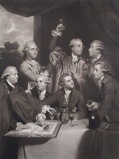
William Say (English engraver, 1768-1834),
after a painting by Sir Joshua Reynolds (English, 1723-1792),
Sir
William Hamilton and Society Dilettante, c. 1780s, mezzotint, 25 1/2 x 18 1/2 inches.
This is a gathering of the members of the Society Dilettante, an exclusive club of British aristocrats dedicated to studying classical art and knowledge on the Grand Tour and as a pastime. As the men enjoy a drink together, Sir William Hamilton (1730-1806), a prominent collector, shows them one of his ancient Greek and Roman vases and a recently published book of engravings of his vase collection. The members are, left to right: Sir W.W. Wynn, Sir J. Taylor, Mr. Payne Galway, Sir William Hamilton, Mr. Richard Thompson, Mr. Stanhope, and Mr. Smith of Heath.
Born to an aristocratic Scottish family, Sir William Hamilton was an enthusiast of the arts and sciences at the height of the Age of Enlightenment. He assembled one of the world's finest collections of Greek and Roman antiquities as British Envoy Extraordinaire to the two Sicilies from 1764-1800. Most of the antiquities he collected came from excavations in Italy, and he later sold most of them to the British Museum. The glories of his vase collection were recorded in portfolios, which served as souvenirs for the great libraries of Grand Tour travelers and patrons, and provided inspiration to decorative art designers in England, such as Josiah Wedgwood (1730-1795).
Also see art criticism, audience, collection, patron, and viewer.
dimension - A measure of spacial distance. The dimensions of three-dimensional spaces or objects are given as height by width by depth, and they are conventionally listed in that order.
If you are given no more than one dimension of an object (not unusual), and need more of its dimensions, here are three ways to obtain them:
1 - Contact the owner of the work, or a representative of the collection in which it resides. It may have a Web site. If the dimensions are insufficiently reported there, find an email address via which someone at the museum might pass your question to an officer who'll answer your query.
2 - Consult a strong library, especially one within an art institution.
3 - If you can find a photograph of the object, measure one dimension you've found cited. Use that measurement against a measurement of the feature in the photo in order to figure a scale for measuring things that distance from the camera. Then measure another dimension of the object in that photo, and using the scale, calculate what must be the object's other dimensions. The more photos you can examine of this object, the more reliable your measurements taken by this method will be. Note such dimensions as "about . . . "
Also see direction, length, mechanical scale, scale, science and art, straight, and visual scale.
ding - A three-legged ritual vessel in Chinese tradition whose origins predate the Shang dynasty (c.1523-1028 BCE). It was used to hold food offered to ancestral spirits, and was also a ground ornament. Fantastic creatures, symbols, even written characters recording ritual procedures were cast into it's surface's design. In its typical Shang form, the ding was a sturdy, lidless vessel mounted on straight legs. In vernacular English, a ding might be a dent.
Also see Chinese art.
![]() dingbat - In graphic
design, dingbats are decorative
or pictorial characters,
most of which might also be called glyphs,
icons, ideograms,
or
dingbat - In graphic
design, dingbats are decorative
or pictorial characters,
most of which might also be called glyphs,
icons, ideograms,
or  pictographs, not corresponding
to any of the letters, numerals,
punctuations or other figures
used in any written language or mathematics.
Sets of dingbats
pictographs, not corresponding
to any of the letters, numerals,
punctuations or other figures
used in any written language or mathematics.
Sets of dingbats ![]() are availableas
fonts designed
by many typographers. Also
called a flubdub.
are availableas
fonts designed
by many typographers. Also
called a flubdub.
Also see babyspot, calligraphy, clip art, foliate, font, fontography, -graph, leading, letterhead, lettering, logo, palmette, petroglyph, pica, text, typeface, ![]() and vignette.
and vignette.
![]()
diodes - Light-sensitive electronic components used in image capture. They function as one-way valves that sense the presence or absence of light and create a digital signal that the computer converts into pixel values.
Also see digital camera, digital image, and digital photography.
diorama - A three-dimensional representation of a scene, either full-scaled or miniature. It may have a background painted to merge with elements nearest it by means of aerial and linear perspective. It may be made on a platform with or without a clear glass front, set into an illuminated niche, and viewed from a darkened area. In miniature form, it may be entirely enclosed, and viewed through a peephole. It has been used for life-size scene in which figures, stuffed wildlife, and other objects are arranged in a naturalistic setting, exhibits of engineering and industrial projects, and advertising displays. In the eighteenth and nineteenth centuries, a popular form of didactic entertainment, often containing a scene reproduced on cloth transparencies with various lights shining through the cloths to produce changes in effect, intended for viewing at a distance.
Examples:
John Heaviside Clark (English, 1770-1863), The Portable Diorama, 1826, painted and varnished wood, canvas, aquatint, and watercolor; six foreground images: each 6 x 8 5/8 inches; six background images: 7 3/4 x 10 1/2 inches; box: 4 7/8 x 13 1/8 x 10 3/8 inches, Getty Research Institute, Malibu, CA. This is one of 22 objects in the Devices of Wonder exhibit catalogued online by the Getty Museum -- best seen with Flash and RealAudio plugins.
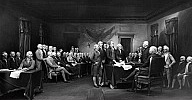
Bartlett Frost (American) (after: John Trumbull [American, 1756-1843]), Declaration of Independence, 1969, diorama:
wax figures and mixed media, 194 x 142 x 99 cm. (76 3/8 x 55 7/8 x 39 inches), National Portrait Gallery, Washington, DC. Placed in Independence Hall, Philadelphia, the sitters include: John Adams,
Roger Sherman,
Robert Robert Livingston,
Thomas Jefferson,
Benjamin Franklin,
Charles Thomson,
and John Hancock.
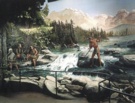
Larry Watson and Peggy O’Neal (American, contemporary), designers, The Kuuich Indians Fishing, part of the "Tidewaters and Time" exhibit, mixed media, Umpqua Discovery Center, Reedsport, Oregon. Typical of dioramas in museums of natural history, a handrail keeps the audience from getting too close; the foreground components of this diorama's composition are three-dimensional and full-scale, while the background consists of an illusionistic painting on a flat or curving surface. The areas where these two means of representation meet form as subtle a transition as possible.
Also see panorama and taxidermy.
diorite - An igneous rock, extremely hard and usually black or dark gray in color.
diptych - A picture or bas-relief made of two panels hinged together, often an altarpiece. Also, any picture consisting of two individual surfaces. Also, an ancient Roman or Early Christian two-hinged writing tablet, or two ivory memorial panels.
(pr. DIP-tək)
Examples:

Jan van Eyck (Netherlandish, c. 1395 [active
by 1422] - 1441) and Workshop Assistant, The Crucifixion and the Last Judgment,
c. 1430, oil on canvas,
transferred from wood, each 22 1/4 x 7 2/3 inches (56.5 x 19.7
cm), Metropolitan Museum of Art, NY. (On the Met's page, you
can enlarge any detail.) See hieratic
and Middle Ages.

John Adams Whipple (American, 1822-1891),
Cornelius Conway Felton with His Hat and Coat,
early 1850s, daguerreotype,
visible: 8.3 x 7 cm (3 1/4 x 2 3/4 inches) each, Metropolitan
Museum of Art, NY.
Blinky Palermo (German, 1943-1977), Flipper, 1970, diptych screenprint, 31 1/2 x 23 5/8 inches (80 x 60 cm); publisher: Galerie Heiner Friedrich, Munich/NY; printer: Atelier Laube, Munich; edition: 90; Museum of Modern Art, NY.
David Salle (American, 1952-), Unpublished, 1983, acrylic on canvas, diptych: 76 1/2 x 105 1/2 inches, Museum of Contemporary Art, Los Angeles.

Wangechi Mutu (Kenyan, 1972-), Yo Mama, 2003, cut-and-pasted printed paper, cut-and-pasted pressure-sensitive synthetic polymer sheet, synthetic polymer paint, and pencil with glitter on two sheets of painted paper, 59 1/8 x 85 inches (150.2 x 215.9 cm), Museum of Modern Art, NY. See African art.
Also see Roman art and triptych.
direct carving - A carving technique in which the form of the sculpture evolves as the artist works into the block, or is suggested by the shape of the block.
direct casting - In lost-wax casting, a technique in which the original model is lost — melted out of the mold. If the work is hollow, the wall of metal is generally heavy — the wax model having been modeled thickly over a core of very simple shape.
Also see indirect casting.
direction - This may refer either to actual or implied movement, or to an angle or a point of view. Demonstrating how much we take direction for granted, some of the following examples depict places where up and down — fundamental directions upon which we orient ourselves to the world — are impossible to determine consistently:

Maurits Cornelis Escher (Dutch, 1898-1972),
Gallery, 1946 (1st state), till 1949
(further states), mezzotint,
4th state. See a colorful variation on this image, called Other
World, 1947, wood engraving
and woodcut
in black, reddish brown, printed from 3 blocks. See optical
illusion and state.
![]()
Maurits Cornelis Escher, Up and Down, 1947, lithograph in brown.
![]()

![]()
Maurits Cornelis Escher, Relativity, 1953, lithograph.

A. Prieto (Cuban), designer, Comisión de Orientación Revolucionaria, publisher, Todos a la Plaza . . . (All to the square, July 26 - 17th Anniversary), 1970, silkscreened poster, 104 x 67 cm. Few graphic devices are more certain to control the direction of a viewer's gaze than a set of arrows. Prieto produced a radial pattern of them to draw citizens to the annual celebration of the start of the Cuban Revolution, the event that led to the establishment of Fidel Castro's government.
![]()
Pre-school children were given a test. "In which direction is this bus traveling — left or right?"
Four-year-old children almost always answered "left." When asked, "Why do you think the bus is traveling in the left
direction?" they typically answered: "Because you can't see the door."
|
|---|
Quote:
Also see arrangement, balance, bias, depth, diagonal, dimension, focal point, heuristic, horizontal, labyrinth, length, line, negative, order, parallel, perpendicular, polarizing, positive, qiblah, refraction, rhythm, sequence, straight, tangent, teacher, vertical, and weight.
director - Among those in art careers, the person in a museum who is in charge of its administration, fund-raising, and public relations.
Also see conservator, curator, docent, preparator, and registrar.
directrix - The fixed curve traversed by a generatrix in generating either a cone or a cylinder.
(pr. de-rek'triks)
The plural form can be either directrixes or directrices.
disabilities, artists with - See VSA arts.

disc grinder - A grinder composed of one or two discs. When there are two discs, one is stationary and one moving, and grind the material between them.
Also see abrasive.
discipline-based art education (DBAE) - An approach to art education integrating content from four distinct disciplines, or branches of knowledge: art production, art history, art criticism, and aesthetics. This approach, formulated in the late 1980's, differs significantly from the "creative self-expression" approach that dominated the field during the previous forty years. The content of that earlier approach was exclusively the making of art for self-expression, in a personal exploration of a variety of art materials and methods. DBAE is a more holistic, comprehensive, and multifaceted approach to art education. Not only do teachers incorporate painting, drawings, sculpture, and architecture into their lessons, but they also include fine, applied, craft, and folk arts, such as ceramics, weaving and other textile arts, fashion design, and photography. Students work with and study a variety of visual images and objects that carry unique meaning for human beings from all cultures and times. Although there are DBAE curricula, DBAE itself is an approach to instruction and learning in art and not a specific curriculum; though it should have sequential, cumulative, and articulated implementation. It exists in many forms to meet the needs of the community in which it is taught. Examples of variation include selecting one or more of the disciplines as a central or core discipline(s) for helping students understand works of art; featuring settings such as art museums or community centers and the original artworks they collect or display; integrating the arts with other subject areas; and pursuing newer technologies. DBAE requires content derived from valid information and practices within the professional art world, much as content for the study of mathematics, history and literature is derived from those professional fields.
discoloration - A stain.
Also see art conservation, fugitive colors, patina, permanent pigment, and solvent.
discovery - To find, learn of, or observe; gaining knowledge of something not known before. Special credit goes to one who is the first to do these things. More important in practice, discovery is an early stage in the creative process, involving investigation or research into what others have found, learned or observed.
discrimination - To recognize differences and act upon that awareness.
Also see attitude, lookism, political correctness, praise, stereotype, taste, xenophilia, and xenophobia.
discussion - An earnest conversation of a subject by a group.
Quote:
Also see argument, charette, and critique.
disfigure - To deform, damage, or spoil the appearance or shape of an object.
Quote:
Also see aesthetics, aesthetician, beauty, distort, fragment, grotesque, iconomachy, ugly, and vandalize.
disordered stage - Of Victor Lowenfeld's Stages of Artistic Development, the disordered stage is the first sub-stage of the first stage, the scribble stage. The Scribble stage typically occurs at 2-4 years old. The disordered stage is characterized by uncontrolled markings that could be bold or light depending upon the personality of the child. At this age the child has little or no control over motor activity.
Related link:
Also see preschematic stage (4-6), schematic stage (6-9), dawning realism stage (9-11), and the pseudorealistic stage (11-13).
di sotto in sù - A technique of representing perspective in ceiling painting. Literally, "from below upwards."
Also see bird's-eye view, dome, and worm's-eye view.
display type - In typography, type used to attract attention. Letters are usually 18 points (1/4 inch) or larger in height. Also see font.
dissonance - A contrast lacking in agreement, consistency, or harmony. A harsh, conflicting, and disagreeable combination of sounds; discord. In music, a combination of tones conventionally considered to suggest unrelieved tension and require resolution.
Also see frisson, grotesque, incongruity, irony, juxtaposition, principles of design, ugly, and variety.
distance learning - Various methods for taking courses, inservices, and other forms of instruction via television, e-mail, the World Wide Web (WWW), and other electronic technology.
distemper - A water-soluble paint using egg-yolk or glue size as a binder. Used mostly for flat indoor wall decoration.
Example of work produced with distemper:

Andrea Mantegna (Italian, 1495-1505), Adoration of the Magi, distemper on linen, stretcher
size: 21 1/2 x 27 3/8 inches (54.6 x 69.2 cm), J. Paul Getty
Museum, Malibu, CA. See Renaissance.
distort, distortion - To change the way something looks — sometimes deforming or stretching an object or figure out of its normal shape to exaggerate its features — making it more interesting or meaningful. El Greco's (Greek-Spanish Mannerist painter, 1541-1614) elongated figures are examples of moderate distortion.
Other examples:
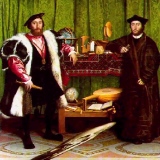

Hans Holbein (German, 1497/8-1543), The Ambassadors,
oil. An anamorphic
human skull in the lower third of the painting can be seen
undistorted
only from a viewpoint that is near and below the painting, and
to its left. See vanitas.
"Weegee", Usher Fellig (born 1899, in Lemberg [also know as Lvov], Austria [now Ukraine], moved to New York 1906, died in New York in 1968) was a photographer who employed various methods for distorting photographs, using unusual lenses and other materials with his camera and enlarger. See the ICP exhibit on Weegee's career. Also see filter, lens, and photography.

Pablo Picasso (Spanish, 1881-1973), Guernica,
1937, oil on canvas,
11 feet 5 1/2 inches x 25 feet 5 3/4 inches, Prado, Madrid. Guernica
was photographed at several
stages of Picasso's work on it. See Cubism.

André Kertèsz (Hungarian, 1894-1985), Distortion #88, c. 1933, gelatin-silver print, 11 x 14 inches (27.94 x 35.56 cm), Los Angeles Museum of Modern Art. See Hungarian art, nude, and photography.
Salvador Dalí (Spanish, 1904-1989), The Persistence of Memory, 1931, oil on canvas, 9 1/2 x 13 inches, Museum of Modern Art, NY. See Surrealism.
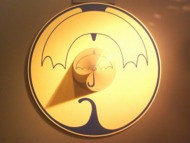
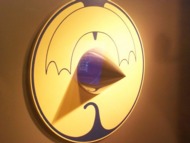
An Umbrella, 20th century. An anamorphic
image is drawn on a circular ground. It is actually a distorted
depiction of an umbrella. It can be seen undistorted only be
placing a conical mirror
upon its center, and looking at it from one particular position.
The undistorted umbrella can be seen in the center of this photograph.
The
same two objects, as seen from off to one side. Here the
reflection in the cone makes no sense as an umbrella, because
our point of view is not at the correct angle.

Here is an animation
of four pictures, each an arrangement
of colored squares
of decreasing size, increasing
number, and increasing complexity.
All are greatly distorted versions of a certain painting. This experience might
be described as achieving
closure or making a new gestalt. See derived
image, metamorphosis,
pixel, and sequence.
Quote:
Also see abstraction, anamorphosis,
antiquing, aspect ratio, beauty, deformalism,
dent, derived
image, description, discoloration, disfigure,
distress, expression, Expressionism, fish-eye
lens, fragment, Futurism, grotesque,
implied, kerf,
lacuna, letterform,
literal qualities, Mannerism, metamorphosis,
optical illusion, reversals,
stress, transform,
ugly, and wide-angle
lens.
distress, distressed - Distressed material that is nicked and scratched, or in other ways shows signs of age, received through use, abuse, exposure to the weather, etc., or through artifice.
Also see abrasive, antiquing, carve, dent, discoloration, disfigure, distort, fragment, lacuna, palimpsest, patina, permanence, stain, stress, and time.
diversity - See difference, multiculturalism, and xenophilia.
divisionism - A system of painting in small dots of color placed in relation to each other based on certain color theories.
Also see neo-impressionism, pointillism, and Segantini
stitch.
https://inform.quest/_art